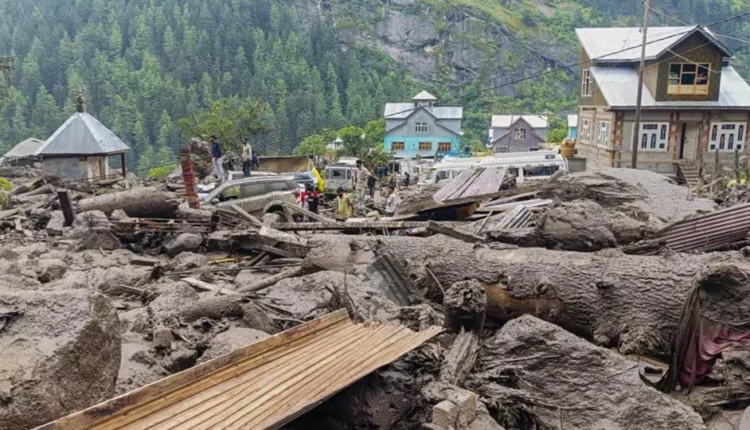Kishtwar Cloudburst: Grief, Grit, and the Hard Science Behind a Himalayan Catastrophe
Chosoti (Chasoti), Kishtwar — 14 August:
In the wake of a sudden cloudburst that ripped through the base-camp town for the Machail Mata Yatra, the landscape of Chosoti turned into a slurry of rock, timber, and twisted tin. Purses, utensils, slippers, helmets—small signatures of everyday life—were swallowed by fast-moving debris.
Pilgrims and security personnel were dragged under torrents thick with silt. Medics reported fractured ribs, stone-packed lacerations, mud-filled lungs, and blood loss—injuries consistent with high-energy debris flows.
For hours, villagers, Army soldiers, police, and disaster-response teams clawed through the sludge, ferrying survivors on their backs to the nearest aid posts. Many of the injured had no idea what had struck them—only that the earth had suddenly turned to water and the water to stone.
A video from the site shows a mud-smeared handbag half-buried beneath snapped rafters, tarpaulin shreds, tangled rope, and what looks like a soaked mattress—one object among thousands in a churned graveyard of belongings.
Local leaders on the ground—LoP Sunil Sharma and Kishtwar MLA Shugan Parihar—joined residents and security forces to move bodies to the roadside, covering them with white sheets, comforting families as children, many unconscious, were rushed for IV fluids and oxygen.
What we know about casualties (as of August 15, Asia/Kolkata)
Official tallies are still shifting as rescue teams reach isolated pockets. Early consolidated figures from multiple agencies and outlets indicate:
- At least 45–50 confirmed fatalities as of Friday morning, with reports ranging from 45 to 56 depending on the source and time of filing. Over 100 people are injured, and scores remain missing. Rescue forces from the J&K Police, SDRF, NDRF, Army, IAF, CISF, and CRPF are engaged, with the yatra suspended.
Kishtwar Additional SP Pradeep Singh told ANI that 45 deaths had been confirmed and 100+ injured shifted for treatment, with identification ongoing and more updates expected as searches continue. (Figures corroborate the range above reported through Thursday/Friday bulletins.)
Why did this happen? (Cloudbursts in the Himalaya, explained)
A cloudburst is an extreme, hyper-local downpour—often >100 mm/hour—that dumps huge volumes of rain over a very small area. In steep Himalayan catchments, this converts slopes into debris-laden flash floods within minutes. Key drivers include:
- Orographic uplift: Moist monsoon air slams into mountains, rises, cools rapidly, and condenses into intense convection.
- Topographic funnels: Narrow valleys accelerate flood waves and trap debris.
- Warmer atmosphere = more moisture: A hotter air mass holds more water vapour, priming the system for heavier bursts. Studies and expert explainers link the frequency and intensity of extreme rainfall in the Himalaya to anthropogenic warming and aerosols, raising the baseline risk for such events.
In Kishtwar, the burst struck midday along the pilgrimage corridor, smashing a community kitchen and security post, catching crowds at rest. Weather offices had warned of intense rain, flash floods, and landslides; yet the sheer intensity and localization overwhelmed any practical lead time.
How does this tragedy compare to past Himalayan disasters
Cloudbursts and related high-mountain hazards are not new, but the exposure of people and infrastructure has grown:
- Kedarnath/Uttarakhand 2013: A combination of cloudburst-like extreme rain and a breached moraine-dam lake triggered cataclysmic floods and debris flows, with ~6,000 deaths.
- Leh–Ladakh 2010: Nocturnal cloudburst and debris flows caused ~255 deaths, devastating Leh and surrounding villages.
- Kishtwar (Honzar) 2021: A local cloudburst killed ~26 and injured 17—an earlier warning of the district’s vulnerability.
- Sikkim GLOF 2023: Heavy rain plus glacial-lake failure sent a wall of water down the Teesta, killing 40–70+ (estimates vary by source) and destroying the Teesta-III dam—an example of compound risks (extreme rain + glacial systems + infrastructure).
Takeaway: The Himalaya faces a stacked hazard deck—steep terrain, intensifying extremes, expanding roads/tourism/settlements in narrow valleys, and fragile slopes. When a cloudburst hits where crowds congregate (pilgrimages, bazaars, camps), casualty potential spikes.
The situation on the ground (today)
- Rescue & Relief: Multi-agency teams (Police/SDRF/NDRF/Army/IAF) are searching for the missing, moving critically injured to district hospitals. Air assets are being tasked as the weather window allows. Machail Yatra remains suspended.
- Governance response: The LG’s office and Union Home Ministry are coordinating with local administration; additional NDRF teams have been pushed from Udhampur. Leaders across parties have called for urgent relief and a review of hazard management along pilgrimage routes.
- Toll updates: As access improves, fatality and missing counts may change. Current credible ranges reported are 45–56 dead, 100+ injured, and dozens to 200+ missing, depending on outlet and timestamp.
What can reduce future risk?
- Hazard-aware route planning for pilgrimages and festivals: avoid high-exposure chokepoints; identify safe vertical/horizontal refuges.
- Real-time early warnings: dense rainfall radar coverage, valley-level sirens, SMS alerts, and trained volunteers to execute rapid evacuation playbooks.
- Nature-based slope management: debris traps, check-dams sized for extreme flows, and strict controls on riverbank construction.
- Crowd and camp management: dynamic caps based on weather indices; mandatory contingency drills for langars/base-camps.
- Climate adaptation mainstreaming: design for extremes, not averages—because the new normal is volatility. (Recent disasters show the cost of underestimating compound risks.)
#Kishtwar #Chosoti #Cloudburst #MachailMataYatra #JammuAndKashmir #FlashFloods #HimalayanDisasters #RescueOperations #DisasterResponse #ClimateRisk #ExtremeRainfall #EarlyWarning #IndiaNews #Monsoon2025 #StaySafe

